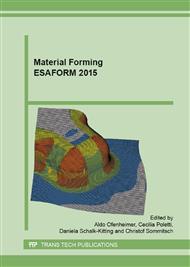p.3
p.9
p.15
p.21
p.27
p.32
p.38
p.47
Flow Localization Modelling in Ti Alloys and Ti Matrix Composites
Abstract:
Titanium-based alloys are commonly applied to aerospace, medicine and energy due mainly to their high specific mechanical properties and high corrosion resistance. Reinforcement with particles further improves their specific strength and stiffness. In previous studies, the hot formability of both unreinforced Ti6Al6V2Sn alloy, and reinforced with 12%vol of TiC particles was analyzed by hot compression tests carried out by means of Gleeble device and metallography. It was observed that the hot workability of these materials is limited at given forming conditions by non-desirable shear bands, voids, as well as micro- and macro cracks, especially in the composite. In this work, damage during hot deformation is predicted by damage models coupled to FEM. Therefore, the flow localization parameter α described by thermal and microstructural softening and the strain rate sensitivity are computed and implemented in DEFORMTM 2D to describe the localization of the plastic flow. The results show intense flow localization as a combination of low dynamic restoration (given by small m values) and temperature gradient. The damage analysis combined with the Cockcroft and Latham continuum cumulative stress model.
Info:
Periodical:
Pages:
3-8
Citation:
Online since:
July 2015
Authors:
Price:
Сopyright:
© 2015 Trans Tech Publications Ltd. All Rights Reserved
Share:
Citation:


